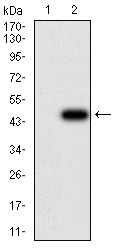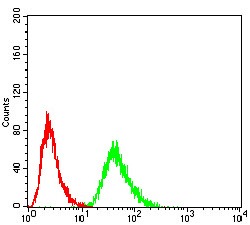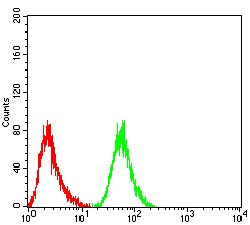Shopping Cart
Remove All Your shopping cart is currently empty
Your shopping cart is currently empty
Anti-RF1 Antibody (8B803) is a Mouse antibody targeting RF1. Anti-RF1 Antibody (8B803) can be used in FCM,WB.
| Pack Size | Price | USA Warehouse | Global Warehouse | Quantity |
|---|---|---|---|---|
| 50 μL | $297 | 7-10 days | 7-10 days | |
| 100 μL | $426 | 7-10 days | 7-10 days |
| Description | Anti-RF1 Antibody (8B803) is a Mouse antibody targeting RF1. Anti-RF1 Antibody (8B803) can be used in FCM,WB. |
| Synonyms | TB3-1, TB3 1, SUP45L1, Sup45 (yeast omnipotent suppressor 45) homolog like 1, RF1, RF 1, Protein Cl1, Polypeptide chain release factor 1, MGC111066, Eukaryotic translation termination factor 1, Eukaryotic release factor 1, Eukaryotic peptide chain release factor subunit 1, ETF1, ERF1_HUMAN, eRF1, ERF, D5S1995, Cl1 protein |
| Clone | 8B803 |
| Reactivity | Human |
| Verified Activity | 1. Western blot analysis of eRF1 on human eRF1 recombinant protein using anti-eRF1 antibody at 1/1,000 dilution. 2. Western blot analysis of eRF1 on HEK293 (1) and eRF1-hIgGFc transfected HEK293 (2) cell lysate using anti-eRF1 antibody at 1/1,000 dilution. 3. Western blot analysis of eRF1 on different cell lysate using anti-eRF1 antibody at 1/1,000 dilution. Positive control: Lane1: MCF-7, Lane2: T47D, Lane3: MOLT4, Lane4: Raji. 4. Flow cytometric analysis of Hela cells with eRF1 antibody at 1/100 dilution (green) compared with an unlabelled control (cells without incubation with primary antibody; red). 5. Flow cytometric analysis of HepG2 cells with eRF1 antibody at 1/100 dilution (green) compared with an unlabelled control (cells without incubation with primary antibody; red).      |
| Application | |
| Recommended Dose | WB: 1:500-2000; FCM: 1:100-200 |
| Antibody Type | Monoclonal |
| Host Species | Mouse |
| Construction | Hybridoma Monoclonal Antibody |
| Purification | ProA affinity purified |
| Appearance | Liquid |
| Formulation | 1*TBS (pH7.4), 1%BSA, 40%Glycerol. Preservative: 0.05% Sodium Azide. |
| Research Background | Translation is carried out by the ribosome and several associated protein factors through three consecutive steps: initiation, elongation and termination. Termination of protein synthesis takes place when the ribosomal A site is occupied simultaneously by one of three stop codons and by a class 1 translation termination factor. In eukaryotes, this termination factor is the eukaryotic release factor 1 (eRF1), a protein that promotes hydrolysis of the last peptidyl-tRNA on the ribosome. eRF1 activity is stimulated by the association with the GTP-binding protein eRF3. eRF1 forms a quaternary complex with eRF3, GTP and the ribosome. This complex performs a dual role, where, in the "GTP state," it controls the positioning of eRF1 toward the stop codon and peptidyl-tRNA, and, in the "GDP state," it promotes the release of the eRFs from the ribosome. eRF1 contains a highly conserved Asn-Ile-Lys-Ser (NIKS) tetrapeptide, which is essential for the interaction of eRF1 with the ribosome. The gene encoding human eRF1 maps to chromosome 5q31.2. |
| Conjucates | Unconjugated |
| Immunogen | Recombinant Protein |
| Uniprot ID |
| Molecular Weight | Theoretical: 49 kDa. |
| Stability & Storage | Store at -20°C or -80°C for 12 months. Avoid repeated freeze-thaw cycles. |
| Transport | Shipping with blue ice. |
| Size | Quantity | Unit Price | Amount | Operation |
|---|

Copyright © 2015-2026 TargetMol Chemicals Inc. All Rights Reserved.